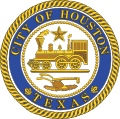Texas Medical Center
| Texas Medical Center | |
|---|---|
| Business district and neighborhood of Houston | |
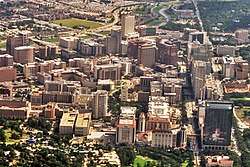 Aerial view of the Texas Medical Center's main campus looking south from Hermann Park. Brays Bayou is visible at the top of the image. | |
| Coordinates: 29°42′22″N 95°24′32″W / 29.7061789°N 95.408837°W | |
| Country |
|
| State |
|
| County | Harris County |
| City |
|
| Institution created | 1945 |
| Government | |
| • Type | Non-profit corporation |
| • Body | Texas Medical Center Corporation |
| Area | |
| • Total | 12.8 km2 (4.93 sq mi) |
| • TMC campus | 5.4 km2 (2.10 sq mi) |
| Population (2012) | |
| • Total | 20,866 |
| • Density | 1,600/km2 (4,200/sq mi) |
| Figures for the combined Medical Center / Astrodome super neighborhood. | |
| ZIP Code | 77030 |
| Area code(s) | 281, 346, 713, 832 |
| Website |
www |
The Texas Medical Center (TMC) is a 2.1-square-mile (5.4 km2)[1] medical district and neighborhood in south-central Houston, Texas, immediately south of the Museum District and west of Texas State Highway 288. Over sixty medical institutions, largely concentrated in a triangular area between Brays Bayou, Rice University, and Hermann Park, are members of the Texas Medical Center Corporation—a non-profit umbrella organization—which constitutes the largest medical complex in the world.[1] The TMC has an extremely high density of clinical facilities for patient care, basic science, and translational research.[1][2][3]
The Texas Medical Center employs over 106,000 people, hosts 10 million patient encounters annually, and has a gross domestic product of US$25 billion.[1] Over the decades, the TMC has expanded south of Brays Bayou towards NRG Park, and the organization has developed ambitious plans for a new "innovation campus" south of the river.[4] The 4.93-square-mile (12.8 km2) Medical Center / Astrodome area, highly populated with medical workers, is home to over 20,000 people.[5][6]
The TMC is serviced by the METRORail Red Line, a north-south light rail route which connects the district to Downtown Houston and NRG Park.
Overview
| Motto | "World Leaders In Patient Care, Research, Education, and Prevention since 1945" |
|---|---|
| Formation | 1945 |
| Type | Non-profit |
| Location | |
President and Chief Executive Officer | William F. McKeon |
Volunteers | 12,000 |
| Website |
www |
The Texas Medical Center contains 54 medicine-related institutions, with 21 hospitals and eight specialty institutions, eight academic and research institutions, four medical schools, seven nursing schools, three public health organizations, two pharmacy schools and a dental school.[7] All 54 institutions are not-for-profit. Among the affiliated medical schools are the University of Texas Health Science Center at Houston, Baylor College of Medicine, University of Texas Medical Branch at Galveston and Texas A&M College of Medicine. Some member institutions are located outside the city of Houston.
More heart surgeries are performed at the Texas Medical Center than anywhere else in the world with 13,600 heart surgeries annually. 180,000 annual surgeries are performed. The TMC performs one surgery every three minutes. Over 25,000 babies are delivered each year, more than one baby every 20 minutes. The Texas Medical Center offers over 9,200 total patient beds.[8]
The Center receives an average of 3,300 patient visits a day, and over eight million annual patient visits, including over 18,000 international patients. The TMC has over 750,000 ER visitors each year. In 2011, the center employed over 106,000 people, including 20,000 physicians, scientists, researchers and other advanced degree professionals in the life sciences.[9] The TMC has over 160,000 visitors each day.
The Texas Medical Center is home to the largest children's hospital in the world (Texas Children's Hospital), as well as home to the largest cancer hospital in the world (MD Anderson Cancer Center).
History
Founding and early years
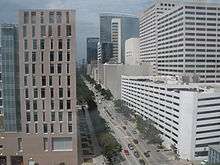
The Texas Medical Center was established in 1945 in part with funds endowed to the M.D. Anderson Foundation by businessman Monroe Dunaway Anderson.[10] The fund's first gift was a check of $1,000 to the Junior League Eye Fund for eyeglasses. In 1941, the Texas State Legislature granted funds to the University of Texas for the purpose of starting a cancer research hospital. M.D. Anderson Foundation matched the state's gift to the university by supplying funds and land on the condition that the hospital be established in Houston, and named after its founder.
President Franklin D. Roosevelt approved the purchase of 118 acres (0.48 km2) from the estate of local entrepreneur George Hermann (namesake of Hermann Park) in 1944 for the construction of a 1,000-bed naval hospital in Houston. The hospital, later renamed the Michael E. DeBakey Veterans Affairs Medical Center, opened in 1946 and became a teaching facility for the Baylor College of Medicine. Also in 1946, several projects were approved for inclusion in the Texas Medical Center including:
- Memorial Hermann–Texas Medical Center (whose campus was pre-existing in the district, having been built in the 1920s)
- Baylor St. Luke's Medical Center, Houston Methodist Hospital
- The Shriners Crippled Children's' Hospital (now known as Shriners Hospitals for Children)
- The Texas Medical Center Library
M.D. Anderson Hospital for Cancer Research of the University of Texas began construction in 1953. Texas Children's Hospital admitted its first patient in 1954.
During the late 1950s, the Texas Institute for Rehabilitation and Research opened. The University of Texas M.D. Anderson Hospital and Tumor Institute at Houston added the Gimbel Research Wing. Texas Woman's University Nursing Program began instruction.
In 1962, the Texas Heart Institute was chartered and became affiliated with Baylor St. Luke's Medical Center (known then as St. Luke's Episcopal Hospital) and Texas Children's Hospital. Ben Taub General Hospital of the Harris Health System (known then as Harris County Hospital District) opened in 1963.
The TMC Library provides access to thousands of current digital books and journals and its John P. McGovern Historical Collections and Research Center houses rare medical books dating back to the 1500s, and historical manuscripts such as the McGovern Collection on the History of Medicine, the Menninger Collection of Psychiatry and Psychoanalysis, and the Atomic Bomb Casualty Commission which recorded the after-effects of the atomic bombings of Hiroshima and Nagasaki.
Recent history and developments
In 1993, The University of Texas M.D. Anderson Cancer Center began a $248.6-million expansion project which constructed an inpatient pavilion with 512 beds, two research buildings, an outpatient clinic building, a faculty office building, and a patient-family hotel. From 2005 to present, the George and Cynthia Mitchell Basic Sciences Research Building, the Ambulatory Clinical Building, the Cancer Prevention Center and a new research building on the South Campus opened. The Proton Therapy Center, the largest facility in the United States where proton therapy is used to treat cancer, opened in July 2006.[11]
In 2001, the Texas Medical Center was devastated by Tropical Storm Allison, which flooded basements and the first floors with 18 inches of water.[12] This resulted in retrofitting of storm doors and barriers to prevent future flooding.
The Memorial Hermann Healthcare System constructed the six-floor, 165,000-square-foot (15,300 m2) Memorial Hermann Heart & Vascular Institute. Also recently completed is the 30-story Memorial Hermann Medical Plaza, which is now the largest medical office building in the Texas Medical Center. At night, it is recognizable by its unique rainbow lantern.[13] The new construction is part of the system's citywide "Century Project" initiative.
In 2005, Baylor College of Medicine opened the Baylor Clinic.
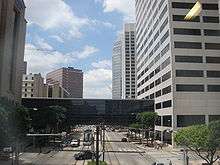
The Texas Children's Hospital announced the largest investment and program expansion ever by a single pediatric organization. The $1.5 billion, four-year initiative is targeted for completion in 2010 and focuses on research and accessibility. Major projects include the development of the neurological research institute ($215,000,000), the formation of a maternity center ($575,000,000), and the expansion of existing research facilities ($120,000,000). Texas Children's is embarking on the development of one of the largest pediatric hospitals in a suburban setting ($220,000,000). The remainder of the expenditures is earmarked for new equipment and information systems.[14]
In 2010, the University of Texas Medical Branch at Galveston, including the John Sealy Hospital, became the 49th member of the Texas Medical Center and the first member-institution located outside the City of Houston.[15][16][17]
Texas Medical Center–West Campus, serving residents of greater west Houston and adjacent areas, opened in January, 2011. Representing an initial investment of more than half a billion dollars, and almost 1.2 million square feet of healthcare development, the first two facilities to open in the new campus were the Texas Children’s Hospital and The Houston Methodist West Hospital. Texas Children’s West Campus is among the nation’s largest suburban pediatric hospitals.[18]
In 2012, Texas Medical Center added the Shriners Hospitals for Children in Galveston, which treats pediatric trauma burns, as its 50th member institution.[19]
In 2016, Texas Medical Center added San José Clinic, the community's leading charity care clinic, as a member institution. Denise Castillo-Rhodes, executive vice president and chief financial officer of the Texas Medical Center, as well as a volunteer for San José Clinic noted when it became a member of TMC: "San José Clinic serves a very important role in our community. Thus, it is a natural next step for the Clinic to join the Texas Medical Center as its newest member, as it continues to grow and provide extraordinary healthcare and education at affordable prices."[20].
Cityscape and infrastructure
The Texas Medical Center is a dense agglomeration of hospitals, schools, and ancillary businesses clustered on a triangular piece of land bordered by Rice University and the neighborhood of Southampton to the west, Brays Bayou to the south and east, and Hermann Park to the north. With 106,000 employees, the TMC has an employment density of approximately 50,475 per square mile (19,489/km2). The Texas Medical Center Corporation has compared its dense cityscape to the Chicago Loop and Lower Manhattan.[21]
The core of the TMC is serviced by three large arterial roads. Main and Fannin streets run southwest to northeast, while Holcombe Boulevard runs west to east. The Texas Medical Center is one of the few employment centers in Houston which is not directly serviced by a freeway; the nearest freeway is Texas State Highway 288, located to the east of Hermann Park. To compensate, the TMC has developed strong transit connections; the entirety of the district is serviced by the METRORail Red Line, which runs along Fannin. Rail stops in the Medical Center include Memorial Hermann Hospital/Houston Zoo, Dryden/TMC, and the Texas Medical Center Transit Center, which doubles as a hub for local bus routes. These three stops are the busiest stations on the Red Line; ultimately, the district's bus, light rail, and shuttle services deliver nearly 65,000 trips per day to and from the area.[22]
In the 2010s, rapid development within the Medical Center began to strain existing transportation infrastructure; the average daily traffic on Fannin Street and nearby arterial Kirby Drive is expected to double by 2035.[23] New development during the first half of the decade is expected to require an additional 50,000 parking spaces to meet demand.[23] Solutions to the district's traffic problems include expanding existing arterial roads, boosting transit capacity, and constructing new contract parking lots on the outskirts.[23]
Government services
The Texas Medical Center Corporation is headquartered at the John P. McGovern Campus on Holcombe Boulevard southeast of Hermann Park, adjacent to the Michael E. DeBakey Veterans Affairs Medical Center.[24] The United States Postal Service operates the Medical Center Station on Almeda Road, and Harris County Public Library operates the Texas Medical Center Library near the Baylor School of Medicine.[25][26]
The Houston Fire Department Station 33 Medical Center, a part of Fire District 21,[27] is near the Texas Medical Center at 7100 Fannin at South Braeswood. The original Firehouse 33 was one of the last stations to be housed in an original volunteer fire station. The original Station 33 was the city hall/fire station of Braeswood. The City of Houston annexed the area in 1950. The current Fire Station 33 opened one block from the original station in August 2004. The city relinquished its ownership of the original fire station.[28]
The Texas Medical Center is within the Houston Police Department's South Central Patrol Division.[29]
Residential developments
Formerly TMC had its own employee housing, Laurence H. Favrot Tower Apartments, which accommodated TMC employees and their dependents.[30] On August 31, 2012 the complex closed.[31] Dependent children living there were within the Houston Independent School District (HISD) and zoned to Roberts Elementary School in Southgate,[32] Ryan Middle School in the Third Ward,[33] and Lamar High School in Upper Kirby.[34]
Texas Medical Center Orchestra
Formerly known as the Doctors Orchestra of Houston, the Texas Medical Center Orchestra was established in November 2000 and is one of the few orchestras in the world that originated from health professions. Members of the orchestra include physicians, dentists, nurses, medical students, biomedical scientists, social workers and other health professionals.[35]
The mission of the orchestra is to provide health care professionals with a high-quality outlet for creative expression through the world of symphonic music; perform regularly at affordable concerts that are open to the public and in an accessible venue; attract a diverse audience by commitments to select popular programming reflecting Houston’s diversity; and bring public attention to, and provide programmatic support for, medically related and/or educational charities.[36]
Organizations which have received contributions include: The University of Texas Medical School for heart research; The Ben Taub BOOKS programs; The H.O.M.E.S Clinic; Making a Mark Art Program at Texas Children’s Hospital; HISD's DeBakey High School for Health Professions; Eye Care for Kids Foundation; The Greater Houston Chapter of the American Red Cross; The National Space Biomedical Research Institute; San Jose Clinic; Haddassah; and The Dr. Marnie Rose Foundation.[37][38]
In an effort to increase appreciation for classical music in young audiences, Texas Medical Center Orchestra has developed a close relationship with the charter school, KIPP SHARP.[39] By coordinating efforts with KIPP SHARP teachers and administrators, TMCO has integrated its musical programming into the school's curriculum. Works that the orchestra performs are taught and discussed in history, art and music classes. The students are invited to display artwork and essays in the Wortham lobby at TMCO concerts, and they are encouraged to at attend with their families. TMCO has included KIPP choirs and orchestras in concert performances.[37]
In 2011, TMCO began working with the National Multiple Sclerosis Society, Lone Star Chapter in an annual co-sponsorship of a bicycle ride, "Gran Fondo: Texas TMCO" that precedes the MS150 and benefits both organizations.
Gallery
- Medical Center Station Post Office
- METRO stop in the Texas Medical Center area
- Fire Station 33 Medical Center
- Coleman College for the Health Sciences, part of the Houston Community College system
 Skyline of the University of Texas Medical Branch at Galveston, the 49th member of the Texas Medical Center Corporation
Skyline of the University of Texas Medical Branch at Galveston, the 49th member of the Texas Medical Center Corporation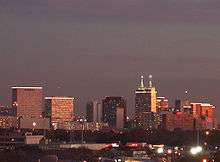 Skyline of the Texas Medical Center
Skyline of the Texas Medical Center
See also
References
- 1 2 3 4 "Facts and Figures". Texas Medical Center Corporation. 2016. Retrieved 2017-09-17.
- ↑ The World’s Largest Medical Center is Now Among the Most Energy Efficient | Department of Energy. Energy.gov (2011-05-18). Retrieved on 2013-09-06.
- ↑ 10 Most Prestigious Medical Centers in the World. Masters in Health Care (2011-04-17). Retrieved on 2013-09-06.
- ↑ Holeywell, Ryan (2015-11-20). "The Texas Medical Center has ambitious plans for a new Houston campus". The Urban Edge. Rice University Kinder Institute for Urban Research. Archived from the original on 2017-09-18. Retrieved 2017-09-17.
- ↑ "Super Neighborhood Resource Assessment – Medical Center" (PDF). City of Houston. August 2014. Retrieved 2017-09-16.
- ↑ "Super Neighborhood Resource Assessment – Astrodome" (PDF). City of Houston. August 2014. Retrieved 2017-09-16.
- ↑ "Unprecedented Life Science Technologies | Texas Medical Center". Retrieved 2016-07-02.
- ↑ "Largest Medical Center in the World | Texas Medical Center". Retrieved 2016-07-02.
- ↑ "2010_FactsAndFigures_FA.pdf" (PDF). Archived from the original (PDF) on 2012-01-26. Retrieved 2010-12-30.
- ↑ MDAnderson.org Biography of M.D. Anderson Archived 2009-03-03 at the Wayback Machine.
- ↑ Juan A. Lozano (16 Jul 2006). "M.D. Anderson opens new proton therapy center". Houston Chronicle. Associated Press. Retrieved 14 Feb 2009.
- ↑ "How these doors could save millions during a flood". abc13.com. 25 August 2017. Retrieved 5 April 2018.
- ↑ Archived November 26, 2006, at the Wayback Machine.
- ↑ Texas Children's Hospital Vision 2010. Archived 2012-02-13 at the Wayback Machine. Retrieved 2009-04-03
- ↑ Kappes, Hayley. "UTMB partners with Texas Medical Center". Galveston Daily News. Retrieved 2010-05-13.
- ↑ "UTMB Joins Texas Medical Center: UTMB Is About 50 Miles Away From Texas Medical Center". KPRC Click2Houston. Archived from the original on 2010-03-04. Retrieved 2010-05-13.
- ↑ Wollam, Allison. "UTMB becomes TMC member institution." Houston Business Journal. Tuesday March 2, 2010. Retrieved on March 12, 2010.
- ↑ "Texas Medical Center-West Campus Opens". Texas Medical Center. Retrieved 2011-10-24.
- ↑ Shriners Hospitals for Children — Galveston joins the Med Center | MedBlog | a Chron.com blog. Blog.chron.com (2012-01-04). Retrieved on 2013-09-06.
- ↑ "Texas Medical Center Welcomes New Member San José Clinic - TMC News". TMC News. 2017-01-12. Retrieved 2017-06-22.
- ↑ "A 50 Year Master Plan 2006 Update." Texas Medical Center. 2006. 2 (5/34). Retrieved on January 17, 2010.
- ↑ "Texas Medical Center Mobility Study" (PDF). PlanHouston. September 2014. Retrieved 2017-12-08.
- 1 2 3 Begley, Dug (2014-04-25). "Medical Center mobility centered on big roads for big need". Houston Chronicle. Retrieved 2017-09-25.
- ↑ "About the Texas Medical Center." Texas Medical Center. Retrieved on June 20, 2009.
- ↑ "Post Office Location – MEDICAL CENTER." United States Postal Service. Retrieved on June 20, 2009.
- ↑ "TMC Library." Harris County Public Library. Retrieved on January 31, 2016. " TMC Library 1133 John Freeman Blvd. Houston Texas 77030 "
- ↑ "Fire Stations." City of Houston. Retrieved on May 8, 2010.
- ↑ "Fire Station 33 Archived 2006-09-26 at the Wayback Machine.." City of Houston. Retrieved on May 8, 2010.
- ↑ Crime Statistics for South Central Patrol Division. Houstontx.gov. Retrieved on 2013-09-06.
- ↑ "TMC Services > Favrot Tower Apartments." Texas Medical Center. June 20, 2010. Retrieved on April 22, 2018. "20-Minute Parking (located in the back of the building): 6540 Bellows Lane, Houston, TX 77030"
- ↑ "Favrot Tower Apartments." Texas Medical Center. July 29, 2012. Retrieved on April 22, 2018. "Favrot Tower is closing August 31, 2012."
- ↑ "Roberts Elementary Attendance Zone Archived 2012-02-08 at the Wayback Machine.." Houston Independent School District.
- ↑ "Ryan Middle Attendance Zone Archived 2007-06-30 at the Wayback Machine.." Houston Independent School District
- ↑ "Lamar High School Attendance Zone Archived 2011-09-28 at the Wayback Machine.." Houston Independent School District.
- ↑ "Texas Medical Center Orchestra provides creative outlet for professionals". Houston Chronicle. Retrieved 2017-02-16.
- ↑ "Orchestra is tuned in to music, medicine". Houston Chronicle. Retrieved 2017-02-16.
- 1 2 "What the Doctor Ordered | NEA". www.arts.gov. Retrieved 2017-02-16.
- ↑ "Texas Medical Center Orchestra, Houston Orchestra, Houston Health Professionals, Houston Medical Musicians, TMCO, Houston Medical Orchestra, Gran Fondo Texas TMCO, Doctors Orchestra of Houston, Houston Music Fellowship, Houston Music Charities". www.tmcorchestra.org. Retrieved 2017-02-16.
- ↑ "NEA Arts - Number 4 2010" (PDF). Archived from the original (PDF) on 2014-10-19.
External links
| Wikimedia Commons has media related to Texas Medical Center. |
- Texas Medical Center Homepage
- Texas Medical Center Maps and Driving Directions
- Texas Medical Center from the Handbook of Texas Online
- Texas Medical Center News Homepage
Coordinates: 29°42′34″N 95°23′53″W / 29.70951°N 95.39818°W

